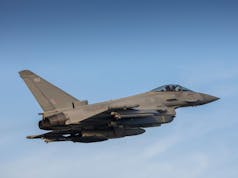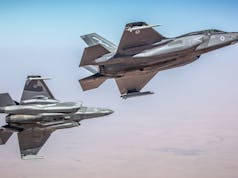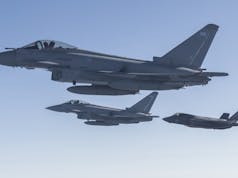The Ministry of Defence is seeking industry input for a new rapid-launch drone system under “Project VOLLEY”, aiming to field multiple mobile launchers capable of deploying five drones in under four minutes—with each drone launched at one-minute intervals.
Described in a newly published Prior Information Notice, the MOD states the requirement is for the “rapid launching of multiple fixed-wing Uncrewed Air Vehicles (UAV), from a single launcher, including set-up, firing and recovery time.”
The launcher must be able to “launch at least 5 reference UAVs within 4 minutes of the first UAV launch and recover within a maximum of 10 minutes from that first UAV launch, from a static and level position.”
Notably, the MOD specifies that the UAVs will be unpowered during launch, and “will not make use of any rocket assisted take off (RATO) boosters or any other launch mechanism other than the Pj VOLLEY launcher.”
Key technical requirements include:
Launching UAVs up to 125kg in weight at speeds of at least 60m/s (200 km/h)
Minimal setup and manual operation by ideally one person and no more than three
Operation in temperatures ranging from -20 to +55°C
Functionality in day/night, gloved, and NVG conditions
Deployment from vehicles such as a “large body Sprinter truck” or “regular Transit van”
The full system must not exceed 275kg
The MOD emphasises that the system must be “robust, simple to assemble and capable of launching numerous UAVs without replacement of high wear / perishable parts,” and able to “withstand jet efflux, fuel spills, handling damage,” and operate with a “minimal signature (acoustic, heat, visual)… hiding in plain sight.”
Moreover, “System launch angle must be easily adjustable to account for various UAV launch/take-off characteristics; assume minimum inclination of 8 degrees and up to a maximum of 30 degrees.”
The Ministry is also clear about what it does not want. It excludes “autonomous launchers,” launchers “not operated by a human crew,” and any solution “that will not be ready for UK field demonstration / testing in October 25.” RATO-based solutions are also explicitly ruled out.
While a complete system is welcomed, the MOD says it is open to partial solutions. “If your product answers part of this VOLLEY challenge problem statement, we encourage you to participate,” the notice adds.
The timeline for industry engagement is as follows:
- Industry Day: 18 June 2025
- “Dragon’s Den” competition: 1 August 2025
- Field demonstrations: October 2025
- First deliveries: No later than January 2026
Importantly, the notice signals that “a large number (>20) of launchers are anticipated to be needed approximately 6 months from Industry Day / launch of competition.” Each production launcher must be priced under £300,000 and “be produceable at scale.”
The MOD adds that “a small number of proposals (2–5), subject to contract, will be provided funding to demonstrate the entire VOLLEY capability in Oct 25.”
International partners from NATO, Ukraine, and Five Eyes countries are also invited to participate. Registration for the Industry Day closes on 11 June 2025.














White Van Man becomes even more dangerous.
“Transit, the ultimate delivery vehicle”. (just avoid the E version (tiny range, oh and the wet belt ones.)
At least we won’t have to pay VAT if we have cash.
😆 keeping it simple and ….. COTS as far as the launch vehicle at least!
Sadly they are made in Turkey these days.
Nothing wrong with that. Ford (an American company) build their vehicles in many different places.
Interesting that they exclude autonomous launch options. I presume this is for Ukraine and they don’t want the option of a British system being capable of operating in Russia in the way that the recent attack was carried out completely autonomously, as that would open us up to a retaliatory strike here one presumes. Can’t immediately think of any other reason you would exclude that option. Any thoughts?
Don’t follow your reasoning already given the UK has previously given permission to fire Storm Shadows at targets in Russia.
I’m thinking that they’re excluding autonomous launch because, either;
• they want to keep the spec simple as possible
• they already have an autonomous control system, which they’ll then then retrofit to the winning solution (eg whatever was used on Spider Web)
• not needed as the drones aren’t kamikazes (they mention “recovery”) so the people crewing the van can fly them.
Certainly sounds like a set-up for a Spider Web style operation.
Autonomous systems could be dangerous if hacked near the front lines and the drones are launched at the wrong time. Keeping a responsible human in the loop seams to make sense to me.
Park van get out unrolling fiber optic cable so you are a couple of hundred meters away then given the order to launch and confirmation that pilots are ready launch the drones.
If spotted and retaliated against then the human operator is safe
Uk govt wants plausible deniability by saying Ukraine operated , even if uk supplied. This is quite inventive for us. Useful low tech which is game changing. Probably needs Russian transit van or are they buying Chinese over there.
This ‘basic’ tech has all the hallmarks of a domestic security nightmare – sporting events, concerts….policing needs to adapt fast?
Indeed it was bad enough when the IRA launched mortar bombs into the Number 10 garden. The potential of this tech is deeply scary when you think about it and very difficult to see how it can be ultimately defended against in an unpredictable terrorist scenario.
Invent a strong net, like that of a tennis court, placed in a sort of trench hundreds of feet long on all sides of a building.
Sensors detect the Drone, the nets shoot 100 foot in the air and hang there?
Feasible?
Where’s CR? He’s the boffin.🤫
You’ll need a van load of Sky Hooks for that.
What, cope cages for stadiums?
You were the other “Boffin” I had in mind when I typed that! Just up your street.
Hello Daniele,
Obviously, it could be done. The issue is what would it need to look like to be effective. Three things spring to mind. Firstly, the size of the drones you are hoping to stop, you won’t be able to stop them all. Say you chose some up to the size to Iran’s Shahed drones which are a reasonable size. You will need a serious net and or distance from the building to stop them if you want to be able to stop multiple drones arriving in waves. Secondly, you will need to decide what speed of drone or missile you are hoping to stop or defend against. Hypersonic missiles are not going to be stopped by a net around a building, so lets think in terms of high subsonic weapons. Finally, there is the height. The higher the building the heavier the net will be and if we are thinking of high subsonic speeds you will need to get it deployed pretty darned quickly and then hold it up for the duration of the attack which could last several hours! To be honest I don’t think lifting a net up the side of a building would work.
However, you could conceive of a frame on top of the building to which to attach a net and real system and ‘drop’ the net down the side of the building. That would have the advantage that it would not need to go all the way to the ground, so folk could exit the building and head to the shelters. The down side of that is that it would be quite close to the building itself so whilst it might take enough kinetic energy out of the drones / missiles to significantly reduce damage it won’t stop them all. There is also the problem that the net would probably suffer significant damage itself meaning it would likely only be a single use system, which is getting expensive and worse still could leave the building unprotected until the net was replaced.
However, when I was still in the business we wondered what effect barrage balloons would have had on those cruise missiles flying down the streets of Baghdad during the Gulf War. Having some sort of low tech modern equivalent of the barrage balloon might not be as daft as many would assume. The chances of you bringing down a cruise missiles is minimal, but you could force low level cruise missiles to fly higher than they would otherwise do, making them visible to to other defences sooner. In other words they might be useful in some circumstances to shape the battlefield to the advantage of other active defence systems.
So yeh, passive defence measures may yet make a come back in some scenarios, e.g. hilly environments where terrain following might give attackers an advantage. It would come down to cost effectiveness / force mix kind of assessments.
Cheers CR
PS. Boffin 🙂
Thanks for that long consideration mate! 😁
I often wonder what the secret parts of DSTL get up up, and back in the day, your lot.
A Eureka moment is needed.
@Daniele,
You are welcome mate, I enjoy the process.
Cheers CR
Ah, I meant to say something about terrorist attacks. Too many soft targets, you’d have to spend billions protecting every building of value and what is valuable as a target might well have nothing to do with what the building is used for. Detecting this type of ‘van’ attack in these type of circumstances is a nightmare. Intelligence is probably the only effective way to counter these, and luck!
The Ukrainian SBU have been operating straight out the SOE copy book. The thing about these type of operations is that they take a lot of hard work and imagination to pull off, so don’t happen too often. So with this level of effort this type of attack really has to be of strategic value, making the task of the defending assets and forces even more challenging. I think this explains why our security forces have see big increases in budget and increasingly working in a more integrated manner.
In effect the Ukrainian attacks on the Russia strategic bomber force simply highlights what has been possible for a while. The cat is out of the bag!
Cheers CR
On second thoughts, BoffinJ would have been a much better username!
Oh well!
Don’t even need a strong net. Any old garden netting will catch a rotor. You just need a ton of it
I love the way these requests go out now. Keep it brief but be clear and then allow the suppliers to innovate. Short runs and then iterate.
But yes, we’re going to have to do the same on the counter measures side. It will need to be a cost effective solution and not be constrained by limited magazines sizes (in a near peer conflict, how will any air defence system deal with 200 drones with a magazine of only a 100 missiles)?
As for this request, these ‘mother ships’, be they land, sea surface, sub surface or air based are going to accelerate drone warfare to another level, especially if they’re used in the same way as WW1 Q ships (BZ to the Ukrainians).
Disguise and deception are the poor man’s stealth but no less lethal in the right circumstances (and certainly much much cheaper).
A present day HG Wells would probably now be envisioning flying minefields or swarming subsurface mines (or small dirigibles, which are hard to detect, with a mother ship/drone payload).
It normally takes decades for people to work out the full implications of a new technology- uses we can’t even imagine now.
Vauxhall is about to become a player.
😎
Sounds like a dual use “soft launch” missile/drone launcher
A one minute interval between firing ? Isn’t that a bit slow ?
For shoot a scoot yes.
However, I suspect they are trying to keep out of the Gucci zone by specifying overarching easy to hit criteria and not too many of them.
Sounds like a reuse of the Sea Ceptor soft launch tech is suggested?
I would also say it gives the suppliers some leeway. If the contract stated every 10 secs launch you know some supplier like BAE would say yes we can do that on the cheap. Sing the contract then a couple of months later be like no it was always impossible.
At least with a min launch the supplier can come back with for example 50 sec launch and actually be telling the truth
Hmm, a 125kg drone, jet efflux, 60m/s speed..? That is pretty chunky piece of kit they want launching. You ain’t going to get many of them in the back of a Transit Van. The way it is worded they want whatever it is they have in mind to ‘exit’ the van at 60m/s or 120mph! How high is a standard Transit Van? Say 2.5m at the most from the floor to roof. that’s a hell of an acceleration rate! I make it 153g!!!!
Just to be clear it said, “Launching UAVs up to 125kg in weight at speeds of at least 60m/s (200 km/h).” Really? I can only assume some kind of fixed wing thingy!
Whatever it is 153g applied to a 125kg mass is going to do really strange things to a Transit suspension!
That is not going to be a quiet little buzz buzz of a bunch of quadcopters heading off to clobber strategic bombers all nicely lined up for you. The launch cycle is going to make quite a bang to get those numbers so I’m not sure what they are thinking here. Sounds more like MLRS on the [very] cheap rather than drones.
The more I think about it the more it all seems a bit off.
Cheers CR
I would say this is a contract perfect for a SME maybe working alongside one the big defence firms. A lot of defence experts are saying the government needs to start supporting more defence SME.
Sounds like some kind of surveillance system to me.
Vauxhall is about to become a player.
😎
The 1st White Van Man Regiment, to be formed as part of the Strategic Defence Review
😆
Unleashing the strategic power of the transit van..Putin will be for ever looking over his shoulder at the van parked across the road.
I Van the terrible, springs to mind.
How’s a Transit van supposed to traverse and survive the battlefield. This seems more of a gorilla warfare style weapon.
If the Ukrainians can use every available government \ fundraiser (NAFO) vehicles like this van, they can get their hands on, to get on and off the battlefield…
Then so can the British Army!
If not, then we have a serious bloody issue
The Amry does have a serious bloody issue. It needs more tanks, troops, artillery, APCs, basically everything. A van with some drones in it aren’t going to do it much good. Expect grab some headlines.
Not APC’ we need to retain our IFV , revisit Warrior CEC ( there’s at least 14 a full Company’s worth up and running and ready to go ) at least there was before the programme was axed and that was before the Ukraine war when the world looked like a very different place. I got believe how the army seems to be blindly GG king ahead with all the crap decisions that were made before Ukraine and the Osborne/Cameron madness made us pretty much a neutered force. If it’s too.late to revisit Warrior then do what what pretty much every grown up country in NATO is doing and go for CV90 – it is made by BAE Systems in any event. If we can’t have CV90 then at the very least put a decent gun and turret on Boxer, there are plenty of unmanned options out there if we want to retain the full number of dismounts , John Cockerill’s offerings come to.mind. A no brainer to me.
Are all battles fought in fields ?
For the most part yes. Ukrainian’s did some James Bond stuff and should be commended for it, but that doesn’t mean the regular Army can do it.
“For the most part yes”.
Ermm, that’s a no actually.
No seriously, there’s videos online and everything.
Transits are pretty capable and they do a 4×4 version give it a slight lift and some decent tires and with it’s reasonably low weight and decent power you would be surprised at what there capable off.
Don’t use DPD they’ll lose them
🤣🤣🤣🤣
Being DPD’yd is a pain in the arse.
Anyway, what’s the definition of a “Large bodied Sprinter truck” Sprinters and Transits come in pretty much the same number of options as each other. A “Regular Transit” has no meaningful definition either, they are built in a number of different sizes and there are a number of different base models including “Custom and Courier” The larger model Transit is actually called Transit whilst the smaller models are called Transit Custom and Transit Courier.
There is therefore no such thing as a “Regular Transit” and no difference in options between Sprinters and Transits.
The word “Truck” also throws up a number of problems, as does the “Chassis Cab” range of options.
I strongly believe that the person who wrote this sentence really needs to do a little more research.
After all, this is a serious site not a building site.
Should be a Vauxhall Vivaro as they’re still made in the UK (I think, even though Luton closed). Ford closed their van plant over a decade ago. Great confidence in out own industry if we won’t buy things we do still make.
This was invented back in the 4th century! It’s called a Trebuchet!
Another way of looking at the transit requirement is that if it will work on something that size, it would easily work on a wide range of military vehicles. Actually as I think about it, wouldnt a trailer launch option make sense, that could be towed behind almost anything from a landie to a boxer
I’m sure the Trotters would be happy to put in a bid 😁🇬🇧👍🇺🇦
I’m sure the Trotters would be happy to put in a bid 😁🇬🇧
Apols for repeat – ND on phone. To be serious I’m sure we are creating buying these things for Ukraine 🇺🇦and not UK PLC🇬🇧 the reason for the subterfuge being we don’t want to.makw it that obvious that Ivan gets upset.
While there are implications for this, it’s nice to see us taking a leaf out of Ukraine’s book and looking for cheap, simple and readily available options, rather than bankrupting ourselves to buy tiny numbers of super-complicated American stuff. You don’t need a £100m army vehicle to launch drones that can be carried in a £15k van, with the van also having other capabilities that are useful every day as well as being vastly cheaper to run and easier to fix.
£15000 ? more like £50000.
So we want our own shahed drones and launchers.
Well the way procurement works they will cost 30m per van plus drones.
Shouldn’t have poked the bear, now the whole world sees how irrelevant we are